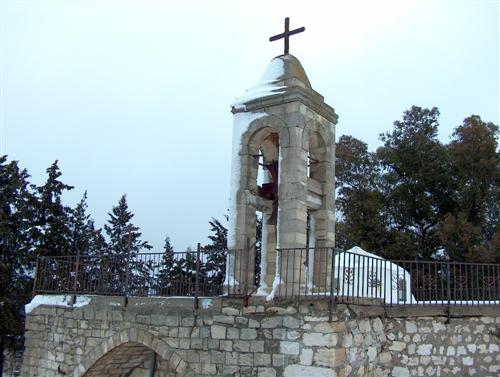:quality(70)/cloudfront-us-east-1.images.arcpublishing.com/mco/5QKRL5HFQJGZDEKAC26C6EIZJE.jpg)
By Philip Athey -- militarytimes.com -- In October of 1983 the then young Lance Cpl. Charles Anderson was nearing the end of his first deployment to Beirut, Lebanon. Anderson was an 0341 mortarman and part of 1st Battalion, 8th Marines 81mm mortar platoon. The battalion had deployed to Lebanon with the 24th Marine Amphibious Unit and was part of a peace keeping force hoping to bring an end to the Lebanese Civil War. Anderson said he saw sporadic combat during the deployment, adding that the barracks and Marine positions around the Beirut airport would routinely receive poorly aimed small arms, rocket propelled grenade and mortar fire. “It just a trickle of fire,” Anderson said Friday afternoon.
But nothing prepared him for the early morning of Oct. 23, 1983, when a yellow 19-ton Mercedes truck crashed through the lobby of the Marine barracks and set off large explosion. The blast killed 220 Marines, 18 sailors and three soldiers. It was the deadliest day for the Corps since the battle of Iwo Jima during World War II. Anderson was in a fighting position with his platoon on the side of the airport strip when he heard the explosion. At first, he believed a random mortar or artillery shell had hit a plane, but all he could see were two mushroom shaped clouds of dust. The Marines at the fighting position quickly pulled out their binoculars to get a closer look. “We were like ‘oh my goodness’ and the building was gone,” Anderson said. “We got to get to the building, we got to get to the building,” he remembers hearing from his platoon’s fighting position.

By Baria Alamuddin* Arab News-- Evidence of Lebanon’s impending collapse piles up by the day: About 230,000 citizens emigrated in the first four months of this year alone, a disproportionate number of whom are Christians. About 40 percent of Lebanon’s doctors and 30 percent of its nurses have departed; with comparable levels among teachers, lawyers, entrepreneurs and other professionals. More are looking to flee as the nation totters on the threshold of civil war, relinquishing all hopes of meaningful, rewarding futures in their beloved homeland. The UN estimates that 82 percent of citizens cannot afford essential services like healthcare and education. With routine operations costing more than a year’s salary, children unable to afford treatment are dying outside hospitals. With the international airport under threat of closure, taxi drivers, lecturers and other segments of society are threatening civil disobedience in response to their desperate situations. Soldiers and policemen on unsurvivable salaries have simply withdrawn from their positions.
As soaring sectarian and factional tensions risk triggering war, the duty of conscientious leaders is to calm the situation. Instead, we got Hassan Nasrallah frenziedly pouring gasoline on the flames, boasting that Hezbollah has 100,000 fighters ready to hurl themselves into battle. One analysis estimated that if Hezbollah actually possesses 100,000 fighters, its annual budget likely far exceeds $2 billion. Given that this is about three times what Hezbollah reportedly receives from Tehran, this either indicates that Nasrallah was grotesquely exaggerating, or was making a tacit admission that Hezbollah has been reaping billions of dollars from illegal activities, like drugs, arms and people smuggling. Nasrallah’s ugly, confrontational speech last Monday was sectarian warmongering personified: He accused Christian leaders of lying to their communities that Hezbollah has an aggressive sectarian agenda, then spent an hour aggressively threatening these communities in the most sectarian language conceivable! Anybody who previously doubted that Lebanon was on the brink of civil war now comprehends exactly which way the wind is blowing. Hidden deep underground, Nasrallah forgets that Lebanon’s population is on the brink of starvation: Hence, his threats simply bestow upon citizens the option of dying slowly, or with a quick, merciful bullet to the head.
٣ اصلاحات دستورية ضرورية وغير معقدة : انتخاب سن ال ١٨ فصل النيابة عن الوزارة اعادة صلاحية تفسير الدستور الى المجلس الدستوري …
by english.aawsat.com — Lebanese Forces Leader Samir Geagea has criticized the military judiciary and accused it of aligning with Hezbollah. Earlier this …
Khazen History


Historical Feature:
Churches and Monasteries of the Khazen family

St. Anthony of Padua Church in Ballouneh
Mar Abda Church in Bakaatit Kanaan
Saint Michael Church in Bkaatouta
Saint Therese Church in Qolayaat
Saint Simeon Stylites (مار سمعان العامودي) Church In Ajaltoun
Virgin Mary Church (سيدة المعونات) in Sheilé
Assumption of Mary Church in Ballouneh
1 - The sword of the Maronite Prince
2 - LES KHAZEN CONSULS DE FRANCE
3 - LES MARONITES & LES KHAZEN
4 - LES MAAN & LES KHAZEN
5 - ORIGINE DE LA FAMILLE
Population Movements to Keserwan - The Khazens and The Maans
ما جاء عن الثورة في المقاطعة الكسروانية
ثورة أهالي كسروان على المشايخ الخوازنة وأسبابها
Origins of the "Prince of Maronite" Title
Growing diversity: the Khazin sheiks and the clergy in the first decades of the 18th century
Historical Members:
Barbar Beik El Khazen [English]
Patriach Toubia Kaiss El Khazen(Biography & Life Part1 Part2) (Arabic)
Patriach Youssef Dargham El Khazen (Cont'd)
Cheikh Bishara Jafal El Khazen
Patriarch Youssef Raji El Khazen
The Martyrs Cheikh Philippe & Cheikh Farid El Khazen
Cheikh Nawfal El Khazen (Consul De France)
Cheikh Hossun El Khazen (Consul De France)
Cheikh Abou-Nawfal El Khazen (Consul De France)
Cheikh Francis Abee Nader & his son Yousef
Cheikh Abou-Kanso El Khazen (Consul De France)
Cheikh Abou Nader El Khazen
Cheikh Chafic El Khazen
Cheikh Keserwan El Khazen
Cheikh Serhal El Khazen [English]
Cheikh Rafiq El Khazen [English]
Cheikh Hanna El Khazen
Cheikha Arzi El Khazen
Marie El Khazen